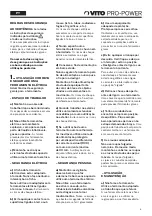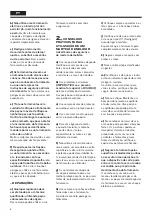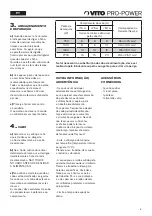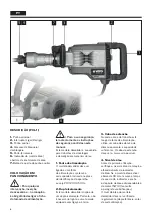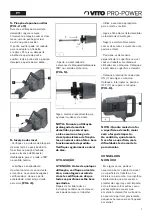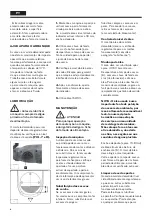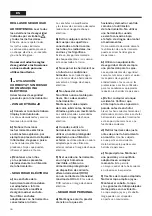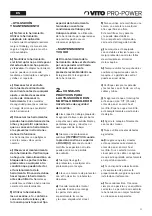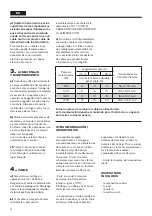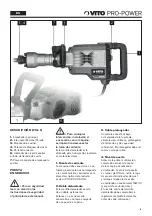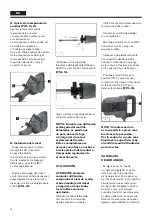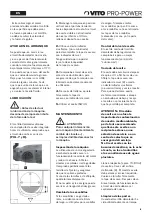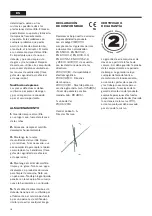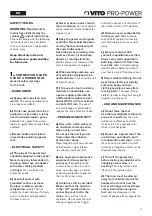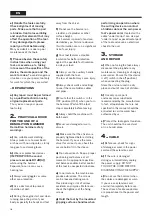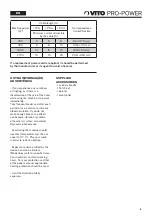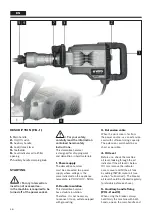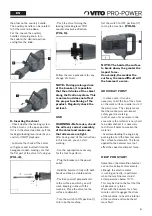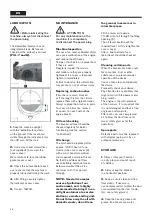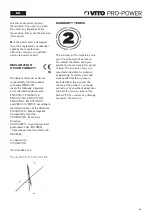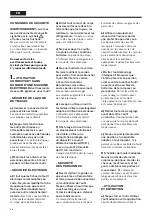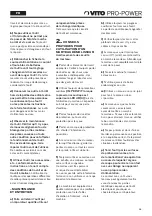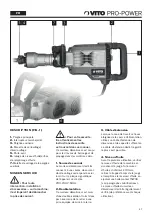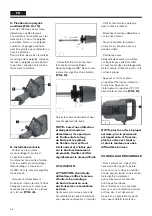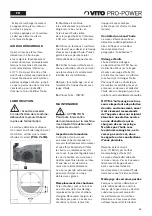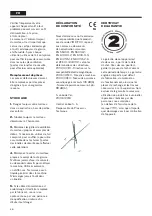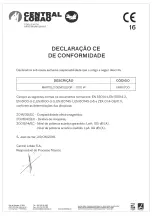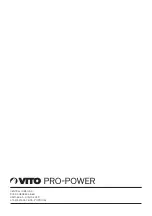
EN
17
SaFetY ruleS
WarninG:
Read all safety
instructions indicated by the
symbol
and all instructions.
Failure to comply with the following
instructions can cause accidents
such as fire, electric shock and/or
serious injury.
Keep all safety rules and
instructions in good condition
for future use.
1.
CorreCt and SaFe
uSe oF a PoWer tool
General safety warnings
for the tool:
- WorKSPaCe
a)
Keep work area clean and
well lit.
The untidy and dark areas
are prone to accidents.
b)
Do not use power tools in an
explosive environment, such as
near flammable liquids, gases
or dust.
The sparks from power
tools can ignite them or make them
explode.
c)
Keep children and visitors
away while operating a power
tool.
- eleCtriCal SaFetY
a)
The plug of the power tool
should be adapted to the socket.
Never make any intervention in
the plug. Never use an adapter
with power tools grounded
or dough.
Thus avoid the risk
of electric shock.
b)
Avoid all contact with
grounded surfaces or mass
(ie pipes, radiators, stoves,
refrigerators, etc.).
The risk
of electric shock increase if a body
part is in contact with grounded
surfaces or mass.
c)
Never expose a power tool to
rain or moisture.
he risk of electric
shock increases if water penetrates
a power tool.
d)
Keep the power cord in good
condition. Never hold the power
cord by the tool and never pull
the cord to disconnect.
Keep the power cord away from
sources of heat, oil and sharp
objects or moving elements.
Electric shock risks increase if the
cord is damaged or entangled.
e)
When working outdoors, use
only extension designed to be
used outdoors.
Thus avoid the risk
of electric shock.
f)
If the use of a tool in a damp
location is unavoidable, use
a power supply protected by
a differential residual current
device (RCD) with a maximum
current of 30 mA.
The use of
an earth leakage circuit breaker
reduces the risk of electric shock.
– PerSonal SeCuritY
a)
Stay alert, watch what you
do and show common sense
when using a power tool.
Do not use the tool if you are
tired, under the influence
of alcohol or drugs.
Never forget that just one second
of inattention is what it takes
to seriously injure yourself.
b)
Use appropriate protective
equipment. Always protect
your eyes.
Depending on the
circumstances, also use a dust
mask, non-slip shoes, a helmet
or hearing protection to prevent
the risk of serious injury.
c)
Avoid any start by accident.
Make sure that the switch is
in the “Off” position before
connecting your tool to the
mains.
To avoid the risk of
accidents, do not move the tool
with your finger on the trigger
and don’t connect it to the mains if
the switch is in the “On” position.
d)
Remove any wrenches before
turning on your tool.
A torque
wrench held captive in a moving
part of the tool can cause serious
injury.
e)
Be sure to always find
yourself in equilibrium position.
Always stay well supported in
both legs and don’t stretch too
much the arm.
A stable working
position allows better control of
your tool in case of fortuitous event.
f)
Wear suitable clothing. Do not
wear loose clothing or jewelry.
Likewise, keep your hair,
clothing and gloves away from
moving parts.
The loose-fitting
clothes, jewelry or long hair can get
caught in moving parts.
– uSe and MaintenanCe
a)
Do not force the tool.
Use the tool adapted to the work
you want to perform.
Your tool
will be more effective and safer
if you use it in the procedure for
which it was designed.
b)
Do not use a power tool if the
switch does not allow to put it
into operation and stop it.
A tool
that can not be turned on and off
correctly is dangerous and must be
repaired imperatively.
c)
Turn off the power tool
before making any adjustments,
changing accessories, or
packing.
There by reduces tool
startup risk by carelessness.
d)
The tools must be stowed
away from children. Do not let
people who do not know the
tool or who have not read these
safety instructions using the
tool.
ools are dangerous in the
hands of people with no experience.

